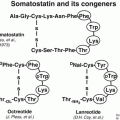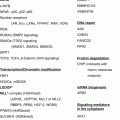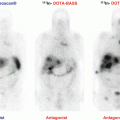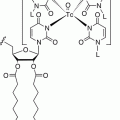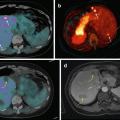Fig. 12.1
1H-NMR spectra of PPGLs. One-dimensional 500 MHz 1H-NMR spectra of PPGL tumor tissues at pH 2.50. Upper panel, sporadic tumor showing normal tumor metabolites like lactic acid, acetic acid, and catecholamines. Middle panel, SDHB tumor showing a high concentration of succinic acid (9.89 nmol/mg tissue). Lower panel, RET tumor showing high resonance of epinephrine and the overlap of the three doublets deriving from ATP/ADP/AMP
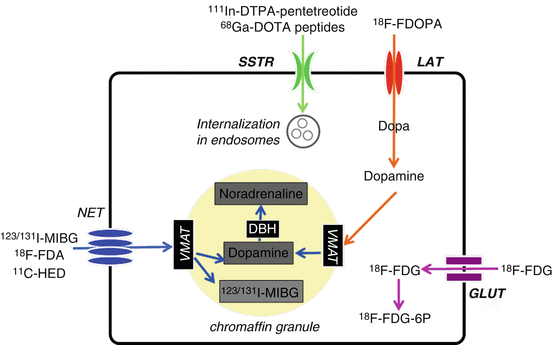
Fig. 12.2
Radionuclide transporters in PPGL tumor cell. GLUT glucose transporter, LAT large amino acid transporter, NET norepinephrine transporter, SSTR somatostatin receptor, VMAT vesicular monoamine transporter
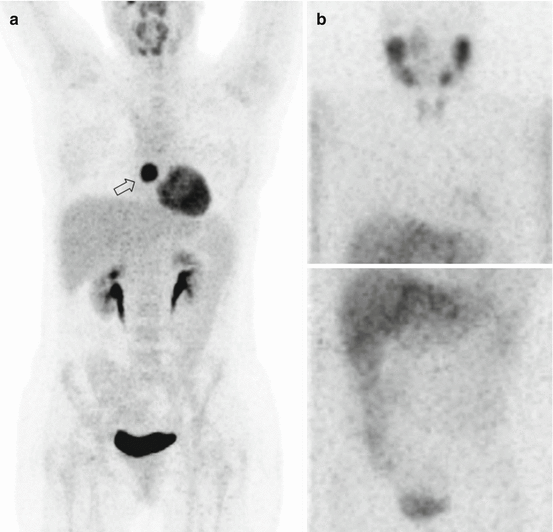
Fig. 12.3
Radionuclide imaging of SDHB PPGL. 18F-FDG PET (panel a) and 123I-MIBG SPECT (panel b) images of patients with a mediastinal PPGL due to a succinate dehydrogenase subunit B (SDHB) mutation. 123I-MIBG fails to detect the tumor (Adapted from Timmers et al. [34])
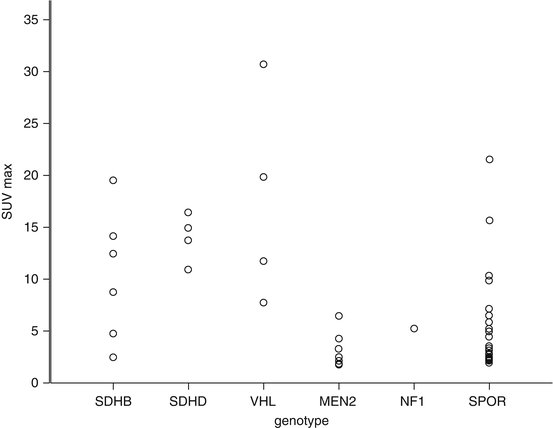
Fig. 12.4
18F-FDG uptake across genotypes. 18F-FDG PET standardized uptake values in non-metastatic PPGLs across genotypes. MEN2 multiple endocrine neoplasia type 2, SPOR sporadic, SUVmax maximum standard uptake value (Adapted from Timmers et al. [34])
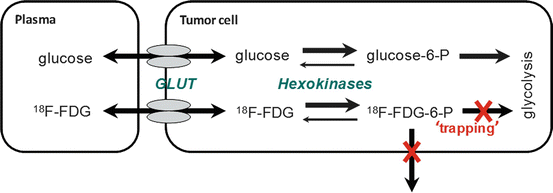
Fig. 12.5
18F-FDG uptake and metabolism in PPGL tumor cell
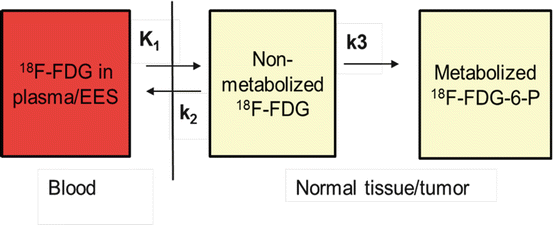
Fig. 12.6
Two-tissue compartment 18F-FDG kinetic model. Transfer rates for transmembranous glucose flux (K1 (in), k2 (out)) and intracellular phosphorylation (k3). EES extravascular extracellular space
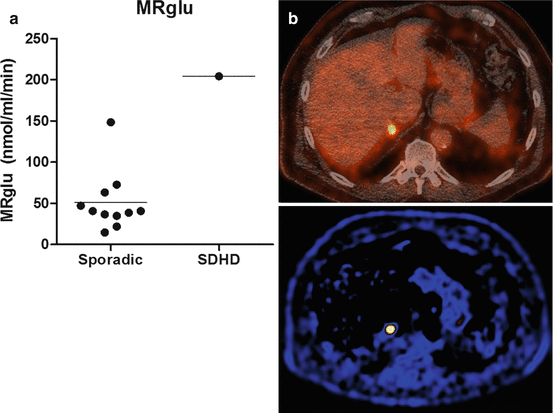
Fig. 12.7
Dynamic 18F-FDG PET scanning. Panel a: the SDHD (succinate dehydrogenase subunit D)-related PPGL stands out from sporadic tumors in regards to metabolic rate of glucose (MRglu). Panel b: 18F-FDG PET-CT fusion image (upper image) and metabolic rate map (lower image) of SDHD-related right adrenal pheochromocytoma (corresponding with SDHD case in panel a)
References
1.
2.
3.
4.
5.
6.
7.
Castro-Vega LJ, Buffet A, De Cubas AA, Cascon A, Menara M, Khalifa E, et al. Germline mutations in FH confer predisposition to malignant pheochromocytomas and paragangliomas. Human molecular genetics. 2014; 23(9):2440–6.
8.
Cascon A, Comino-Mendez I, Curras-Freixes M, de Cubas AA, Contreras L, Richter S, et al. Whole-exome sequencing identifies MDH2 as a new familial paraganglioma gene. J Natl Cancer Inst. 2015;107(5):1–5.
9.
10.
11.
Zhuang Z, Yang C, Lorenzo F, Merino M, Fojo T, Kebebew E, et al. Somatic HIF2A gain-of-function mutations in paraganglioma with polycythemia. N Engl J Med. 2012;367(10):922–30.CrossRefPubMedPubMedCentral
12.
13.
14.
15.
16.
Favier J, Briere JJ, Burnichon N, Riviere J, Vescovo L, Benit P, et al. The Warburg effect is genetically determined in inherited pheochromocytomas. PLoS One. 2009;4(9):e7094.CrossRefPubMedPubMedCentral
17.
Gimenez-Roqueplo AP, Favier J, Rustin P, Mourad JJ, Plouin PF, Corvol P, et al. The R22X mutation of the SDHD gene in hereditary paraganglioma abolishes the enzymatic activity of complex II in the mitochondrial respiratory chain and activates the hypoxia pathway. Am J Hum Genet. 2001;69(6):1186–97.CrossRefPubMedPubMedCentral
Stay updated, free articles. Join our Telegram channel

Full access? Get Clinical Tree



